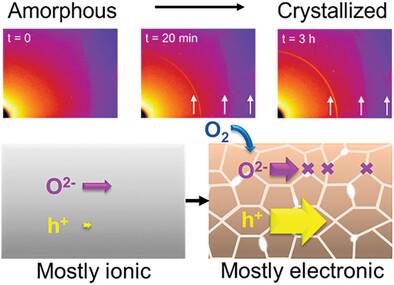当前位置:
X-MOL 学术
›
Adv. Funct. Mater.
›
论文详情
Our official English website, www.x-mol.net, welcomes your feedback! (Note: you will need to create a separate account there.)
Transforming an Ionic Conductor into an Electronic Conductor via Crystallization: In Situ Evolution of Transference Numbers and Structure in (La,Sr)(Ga,Fe)O3‐x Perovskite Thin Films
Advanced Functional Materials ( IF 18.5 ) Pub Date : 2024-06-29 , DOI: 10.1002/adfm.202401854 Haley B. Buckner 1, 2 , Joshua Simpson‐Gomez 1 , Alexander Bonkowski 3 , Kathrin Rübartsch 3 , Hua Zhou 4 , Roger A. De Souza 3 , Nicola H. Perry 1, 2
Advanced Functional Materials ( IF 18.5 ) Pub Date : 2024-06-29 , DOI: 10.1002/adfm.202401854 Haley B. Buckner 1, 2 , Joshua Simpson‐Gomez 1 , Alexander Bonkowski 3 , Kathrin Rübartsch 3 , Hua Zhou 4 , Roger A. De Souza 3 , Nicola H. Perry 1, 2
Affiliation

|
Mixed‐conducting perovskites are workhorse electrochemically active materials, but typical high‐temperature processing compromises their catalytic activity and chemo‐mechanical integrity. Low‐temperature pulsed laser deposition of amorphous films plus mild thermal annealing is an emerging route to form homogeneous mixed conductors with exceptional catalytic activity, but little is known about the evolution of the oxide‐ion transport and transference numbers during crystallization. Here the coupled evolution of ionic and electronic transport behavior and structure in room‐temperature‐grown amorphous (La,Sr)(Ga,Fe)O3‐x films as they crystallize is explored. In situ ac‐impedance spectroscopy with and without blocking electrodes, simultaneous capturing‐synchrotron‐grazing‐incidence X‐ray diffraction, dc polarization, transmission electron microscopy, and molecular dynamics simulations to evaluate isothermal and non‐isothermal crystallization effects and the role of grain boundaries on transference numbers is combined. Ionic conductivity increases by ≈2 orders of magnitude during crystallization, with even larger increases in electronic conductivity. Consequently, as crystallinity increases, LSGF transitions from a predominantly ionic conductor to a predominantly electronic conductor. The roles of evolving lattice structural order, microstructure, and defect chemistry are examined. Grain boundaries appear relatively nonblocking electronically but significantly blocking ionically. The results demonstrate that ionic transference numbers can be tailored over a wide range by tuning crystallinity and microstructure without having to change the cation composition.
中文翻译:

通过结晶将离子导体转变为电子导体:(La,Sr)(Ga,Fe)O3-x 钙钛矿薄膜中迁移数和结构的原位演化
混合导电钙钛矿是电化学活性材料的主力,但典型的高温加工会损害其催化活性和化学机械完整性。非晶薄膜的低温脉冲激光沉积加上温和的热退火是形成具有优异催化活性的均匀混合导体的新兴途径,但人们对结晶过程中氧化物离子输运和转移数的演变知之甚少。本文探讨了室温生长的非晶 (La,Sr)(Ga,Fe)O3-x 薄膜结晶过程中离子和电子输运行为和结构的耦合演化。使用和不使用阻挡电极的原位交流阻抗谱、同时捕获同步加速器掠入射 X 射线衍射、直流偏振、透射电子显微镜和分子动力学模拟,以评估等温和非等温结晶效应以及晶粒的作用转移数的边界被合并。结晶过程中离子电导率增加约 2 个数量级,电子电导率增加幅度更大。因此,随着结晶度的增加,LSGF 从主要是离子导体转变为主要是电子导体。研究了不断演化的晶格结构秩序、微观结构和缺陷化学的作用。晶界在电子上表现出相对无阻挡,但在离子上表现出显着的阻挡。结果表明,通过调整结晶度和微观结构,可以在很宽的范围内定制离子迁移数,而无需改变阳离子组成。
更新日期:2024-06-29
中文翻译:

通过结晶将离子导体转变为电子导体:(La,Sr)(Ga,Fe)O3-x 钙钛矿薄膜中迁移数和结构的原位演化
混合导电钙钛矿是电化学活性材料的主力,但典型的高温加工会损害其催化活性和化学机械完整性。非晶薄膜的低温脉冲激光沉积加上温和的热退火是形成具有优异催化活性的均匀混合导体的新兴途径,但人们对结晶过程中氧化物离子输运和转移数的演变知之甚少。本文探讨了室温生长的非晶 (La,Sr)(Ga,Fe)O3-x 薄膜结晶过程中离子和电子输运行为和结构的耦合演化。使用和不使用阻挡电极的原位交流阻抗谱、同时捕获同步加速器掠入射 X 射线衍射、直流偏振、透射电子显微镜和分子动力学模拟,以评估等温和非等温结晶效应以及晶粒的作用转移数的边界被合并。结晶过程中离子电导率增加约 2 个数量级,电子电导率增加幅度更大。因此,随着结晶度的增加,LSGF 从主要是离子导体转变为主要是电子导体。研究了不断演化的晶格结构秩序、微观结构和缺陷化学的作用。晶界在电子上表现出相对无阻挡,但在离子上表现出显着的阻挡。结果表明,通过调整结晶度和微观结构,可以在很宽的范围内定制离子迁移数,而无需改变阳离子组成。






































 京公网安备 11010802027423号
京公网安备 11010802027423号